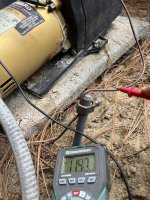While you're ordering and waiting you have hopefully killed the breakers to the pump,
this is critical. Better yet lock out the breakers and/or disconnect wiring to the pump. Better yet, kill power to the light and any other powered devices in and around the pool. Still better and in addition, post Do Not Swim signs. I write this because your analysis shows a bonding problem in addition to the pump problem. While you're waiting, search for a licensed electrician experienced in pool safety and who is NEC knowledgeable. I would also urge you to carefully read of this letter:
Swimming Pools and the Dangers of Electrocution At the bottom of the letter is a link to a video that is also worth watching, as it describes your scenario almost exactly - that link is
YouTube. If any of that sounds too aggressive, it's just that several of us here are trying to save you and those who swim in your pool. One way to view the situation is that it was a stroke of luck to get the warning from the partial pump fault because it helped you identify some other potentially dangerous bonding inconsistencies. Peace be with you, be safe!






